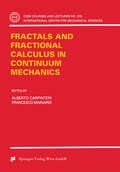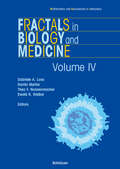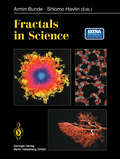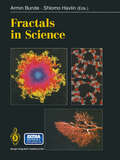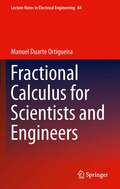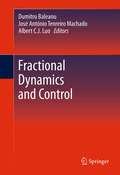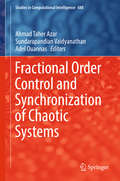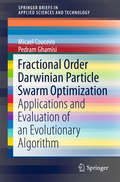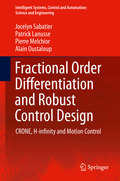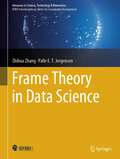- Table View
- List View
Fractals and Fractional Calculus in Continuum Mechanics (CISM International Centre for Mechanical Sciences #378)
by Alberto Carpinteri Francesco MainardiThe book is characterized by the illustration of cases of fractal, self-similar and multi-scale structures taken from the mechanics of solid and porous materials, which have a technical interest. In addition, an accessible and self-consistent treatment of the mathematical technique of fractional calculus is provided, avoiding useless complications.
Fractals in Biology and Medicine: Volume IV (Mathematics and Biosciences in Interaction)
by Gabriele A. Losa Danilo Merlini Theo F. Nonnenmacher Ewald R. WeibelThis volume is number four in a series of proceedings volumes from the International Symposia on Fractals in Biology and Medicine in Ascona, Switzerland which have been inspired by the work of Benoît Mandelbrot seeking to extend the concepts towards the life sciences. It highlights the potential that fractal geometry offers for elucidating and explaining the complex make-up of cells, tissues and biological organisms either in normal or in pathological conditions.
Fractals in Multimedia (The IMA Volumes in Mathematics and its Applications #132)
by Michael F. Barnsley Dietmar Saupe Edward R. VrscayThis IMA Volume in Mathematics and its Applications FRACTALS IN MULTIMEDIA is a result of a very successful three-day minisymposium on the same title. The event was an integral part of the IMA annual program on Mathemat ics in Multimedia, 2000-2001. We would like to thank Michael F. Barnsley (Department of Mathematics and Statistics, University of Melbourne), Di etmar Saupe (Institut fUr Informatik, UniversiUit Leipzig), and Edward R. Vrscay (Department of Applied Mathematics, University of Waterloo) for their excellent work as organizers of the meeting and for editing the proceedings. We take this opportunity to thank the National Science Foundation for their support of the IMA. Series Editors Douglas N. Arnold, Director of the IMA Fadil Santosa, Deputy Director of the IMA v PREFACE This volume grew out of a meeting on Fractals in Multimedia held at the IMA in January 2001. The meeting was an exciting and intense one, focused on fractal image compression, analysis, and synthesis, iterated function systems and fractals in education. The central concerns of the meeting were to establish within these areas where we are now and to develop a vision for the future.
Fractals in Science
by Armin Bunde Shlomo HavlinA deeply detailed discussion of fractals in biology, heterogeneous chemistry, polymers, and the earth sciences. Beginning with a general introduction to fractal geometry it continues with eight chapters on self-organized criticality, rough surfaces and interfaces, random walks, chemical reactions, and fractals in chemisty, biology, and medicine. A special chapter entitled "Computer Exploration of Fractals, Chaos, and Cooperativity" presents computer demonstrations of fractal models: 14 programs are included on a 3 1/2" MS-DOS diskette which run on any PC with at least 1 MB RAM and a EGA or VGA graphics card, 16 colors.
Fractals in Science
by Armin Bunde Shlomo HavlinThe fractal concept has become an important tool for understanding irregular complex systems in various scientific disciplines. This book discusses in great detail fractals in biology, heterogeneous chemistry, polymers, and the earth sciences. Beginning with a general introduction to fractal geometry it continues with eight chapters on self-organized criticality, rough surfaces and interfaces, random walks, chemical reactions, and fractals in chemistry, biology, and medicine. A special chapter entitled "Computer Exploration of Fractals, Chaos, and Cooperativity" presents computer demonstrations of fractal models.
Fractional Calculus for Scientists and Engineers (Lecture Notes in Electrical Engineering #84)
by Manuel Duarte OrtigueiraThis book gives a practical overview of Fractional Calculus as it relates to Signal Processing
Fractional Dynamics and Control
by Dumitru Baleanu, José António Tenreiro Machado and Albert C. J. LuoFractional Dynamics and Control provides a comprehensive overview of recent advances in the areas of nonlinear dynamics, vibration and control with analytical, numerical, and experimental results. This book provides an overview of recent discoveries in fractional control, delves into fractional variational principles and differential equations, and applies advanced techniques in fractional calculus to solving complicated mathematical and physical problems.Finally, this book also discusses the role that fractional order modeling can play in complex systems for engineering and science.
Fractional Fourier Transform Techniques for Speech Enhancement (SpringerBriefs in Speech Technology)
by Prajna Kunche N. ManikanthababuThis book explains speech enhancement in the Fractional Fourier Transform (FRFT) domain and investigates the use of different FRFT algorithms in both single channel and multi-channel enhancement systems, which has proven to be an ideal time frequency analysis tool in many speech signal processing applications. The authors discuss the complexities involved in the highly non- stationary signal processing and the concepts of FRFT for speech enhancement applications. The book explains the fundamentals of FRFT as well as its implementation in speech enhancement. Theories of different FRFT methods are also discussed. The book lets readers understand the new fractional domains to prepare them to develop new algorithms. A comprehensive literature survey regarding the topic is also made available to the reader.
Fractional Linear Systems and Electrical Circuits (Studies in Systems, Decision and Control #13)
by Tadeusz Kaczorek Krzysztof RogowskiThis monograph covers some selected problems of positive and fractional electrical circuits composed of resistors, coils, capacitors and voltage (current) sources. The book consists of 8 chapters, 4 appendices and a list of references. Chapter 1 is devoted to fractional standard and positive continuous-time and discrete-time linear systems without and with delays. In chapter 2 the standard and positive fractional electrical circuits are considered and the fractional electrical circuits in transient states are analyzed. Descriptor linear electrical circuits and their properties are investigated in chapter 3, while chapter 4 is devoted to the stability of fractional standard and positive linear electrical circuits. The reachability, observability and reconstructability of fractional positive electrical circuits and their decoupling zeros are analyzed in chapter 5. The fractional linear electrical circuits with feedbacks are considered in chapter 6. In chapter 7 solutions of minimum energy control for standard and fractional systems with and without bounded inputs is presented. In chapter 8 the fractional continuous-time 2D linear systems described by the Roesser type models are investigated.
Fractional Order Control and Synchronization of Chaotic Systems (Studies in Computational Intelligence #688)
by Ahmad Taher Azar Sundarapandian Vaidyanathan Adel OuannasThe book reports on the latest advances in and applications of fractional order control and synchronization of chaotic systems, explaining the concepts involved in a clear, matter-of-fact style. It consists of 30 original contributions written by eminent scientists and active researchers in the field that address theories, methods and applications in a number of research areas related to fractional order control and synchronization of chaotic systems, such as: fractional chaotic systems, hyperchaotic systems, complex systems, fractional order discrete chaotic systems, chaos control, chaos synchronization, jerk circuits, fractional chaotic systems with hidden attractors, neural network, fuzzy logic controllers, behavioral modeling, robust and adaptive control, sliding mode control, different types of synchronization, circuit realization of chaotic systems, etc. In addition to providing readers extensive information on chaos fundamentals, fractional calculus, fractional differential equations, fractional control and stability, the book also discusses key applications of fractional order chaotic systems, as well as multidisciplinary solutions developed via control modeling. As such, it offers the perfect reference guide for graduate students, researchers and practitioners in the areas of fractional order control systems and fractional order chaotic systems.
Fractional Order Darwinian Particle Swarm Optimization: Applications and Evaluation of an Evolutionary Algorithm (SpringerBriefs in Applied Sciences and Technology)
by Micael Couceiro Pedram GhamisiThis book examines the bottom-up applicability of swarm intelligence to solving multiple problems, such as curve fitting, image segmentation, and swarm robotics. It compares the capabilities of some of the better-known bio-inspired optimization approaches, especially Particle Swarm Optimization (PSO), Darwinian Particle Swarm Optimization (DPSO) and the recently proposed Fractional Order Darwinian Particle Swarm Optimization (FODPSO), and comprehensively discusses their advantages and disadvantages. Further, it demonstrates the superiority and key advantages of using the FODPSO algorithm, such as its ability to provide an improved convergence towards a solution, while avoiding sub-optimality. This book offers a valuable resource for researchers in the fields of robotics, sports science, pattern recognition and machine learning, as well as for students of electrical engineering and computer science.
Fractional Order Differentiation and Robust Control Design: CRONE, H-infinity and Motion Control (Intelligent Systems, Control and Automation: Science and Engineering #10)
by Jocelyn Sabatier Patrick Lanusse Pierre Melchior Alain OustaloupThis book provides an overview of the research done and results obtained during the last ten years in the fields of fractional systems control, fractional PI and PID control, robust and CRONE control, and fractional path planning and path tracking. Coverage features theoretical results, applications and exercises. The book will be useful for post-graduate students who are looking to learn more on fractional systems and control. In addition, it will also appeal to researchers from other fields interested in increasing their knowledge in this area.
Fractional-order Modeling of Nuclear Reactor: A Systematic Approach
by Vishwesh Vyawahare Paluri S. NatarajThis book addresses the topic of fractional-order modeling of nuclear reactors. Approaching neutron transport in the reactor core as anomalous diffusion, specifically subdiffusion, it starts with the development of fractional-order neutron telegraph equations. Using a systematic approach, the book then examines the development and analysis of various fractional-order models representing nuclear reactor dynamics, ultimately leading to the fractional-order linear and nonlinear control-oriented models. The book utilizes the mathematical tool of fractional calculus, the calculus of derivatives and integrals with arbitrary non-integer orders (real or complex), which has recently been found to provide a more compact and realistic representation to the dynamics of diverse physical systems.Including extensive simulation results and discussing important issues related to the fractional-order modeling of nuclear reactors, the book offers a valuable resource for students and researchers working in the areas of fractional-order modeling and control and nuclear reactor modeling.
Fractional Order Signal Processing: Introductory Concepts and Applications (SpringerBriefs in Applied Sciences and Technology)
by Saptarshi Das Indranil PanThe book tries to briefly introduce the diverse literatures in the field of fractional order signal processing which is becoming an emerging topic among an interdisciplinary community of researchers. This book is aimed at postgraduate and beginning level research scholars who would like to work in the field of Fractional Order Signal processing (FOSP). The readers should have preliminary knowledge about basic signal processing techniques. Prerequisite knowledge of fractional calculus is not essential and is exposited at relevant places in connection to the appropriate signal processing topics. Basic signal processing techniques like filtering, estimation, system identification, etc. in the light of fractional order calculus are presented along with relevant application areas. The readers can easily extend these concepts to varied disciplines like image or speech processing, pattern recognition, time series forecasting, financial data analysis and modeling, traffic modeling in communication channels, optics, biomedical signal processing, electrochemical applications and many more. Adequate references are provided in each category so that the researchers can delve deeper into each area and broaden their horizon of understanding. Available MATLAB tools to simulate FOSP theories are also introduced so that the readers can apply the theoretical concepts right-away and gain practical insight in the specific domain.
Fractional-Order Sliding Mode Control: Methodologies and Applications (Studies in Systems, Decision and Control #532)
by Guanghui Sun Xiaolei Li Chengwei Wu Xiangyu Shao Zhiqiang Ma Shidong XuThis book delves deep into fractional-order control and fractional-order sliding mode techniques, addressing key challenges in the control design of linear motor systems and control for the deployment of space tethered systems. Innovative strategies such as adaptive fractional-order sliding mode control and fractional-order fuzzy sliding mode control schemes are devised to enhance system performance. Divided into three parts, it covers a brief view of fractional-order control strength in modeling and control, fractional-order sliding mode control of linear motor systems, and fractional-order sliding mode control for the deployment of space tethered systems. Each chapter offers valuable insights and solutions. Simulations and experiments validate the efficacy of these approaches, making this book essential for researchers, engineers, and practitioners in control systems and aerospace engineering.
Fractional Processes and Fractional-Order Signal Processing: Techniques and Applications (Signals and Communication Technology)
by Hu Sheng YangQuan Chen TianShuang QiuFractional processes are widely found in science, technology and engineering systems. In Fractional Processes and Fractional-order Signal Processing, some complex random signals, characterized by the presence of a heavy-tailed distribution or non-negligible dependence between distant observations (local and long memory), are introduced and examined from the ‘fractional’ perspective using simulation, fractional-order modeling and filtering and realization of fractional-order systems. These fractional-order signal processing (FOSP) techniques are based on fractional calculus, the fractional Fourier transform and fractional lower-order moments. Fractional Processes and Fractional-order Signal Processing: presents fractional processes of fixed, variable and distributed order studied as the output of fractional-order differential systems; introduces FOSP techniques and the fractional signals and fractional systems point of view; details real-world-application examples of FOSP techniques to demonstrate their utility; and provides important background material on Mittag–Leffler functions, the use of numerical inverse Laplace transform algorithms and supporting MATLAB® codes together with a helpful survey of relevant webpages. Readers will be able to use the techniques presented to re-examine their signals and signal-processing methods. This text offers an extended toolbox for complex signals from diverse fields in science and engineering. It will give academic researchers and practitioners a novel insight into the complex random signals characterized by fractional properties, and some powerful tools to analyze those signals.
Fractions, Ratios, and Roots: Rediscover the Basics and Learn About Interesting Applications (essentials)
by Renate MotzerRenate Motzer introduces the world of fractions and connects them with decimal numbers. She clearly shows that fractions can be understood as parts of a whole, but also as ratios of two quantities. The author clearly shows why roots cannot be exactly indicated by fractions, how to find good approximations and why an unusual addition of fractions can lead to paradoxical results. Furthermore, she explains the use of fractions in percentage and probability calculations in a practical way and finally discusses different ways of forming mean values.This Springer essential is a translation of the original German 1st edition essentials, Brüche, Verhältnisse und Wurzeln by Renate Motzer, published by Springer Fachmedien Wiesbaden GmbH, part of Springer Nature in 2018. The translation was done with the help of artificial intelligence (machine translation by the service DeepL.com). A subsequent human revision was done primarily in terms of content, so that the book will read stylistically differently from a conventional translation. Springer Nature works continuously to further the development of tools for the production of books and on the related technologies to support the authors.
Fragmentation of the Photographic Image in the Digital Age (Routledge History of Photography)
by Daniel RubinsteinFragmentation of the Photographic Image in the Digital Age challenges orthodoxies of photographic theory and practice. Beyond understanding the image as a static representation of reality, it shows photography as a linchpin of dynamic developments in augmented intelligence, neuroscience, critical theory, and cybernetic cultures. Through essays by leading philosophers, political theorists, software artists, media researchers, curators, and experimental programmers, photography emerges not as a mimetic or a recording device but simultaneously as a new type of critical discipline and a new art form that stands at the crossroads of visual art, contemporary philosophy, and digital technologies.
Fragmentation of the Photographic Image in the Digital Age (Routledge History of Photography)
by Daniel RubinsteinFragmentation of the Photographic Image in the Digital Age challenges orthodoxies of photographic theory and practice. Beyond understanding the image as a static representation of reality, it shows photography as a linchpin of dynamic developments in augmented intelligence, neuroscience, critical theory, and cybernetic cultures. Through essays by leading philosophers, political theorists, software artists, media researchers, curators, and experimental programmers, photography emerges not as a mimetic or a recording device but simultaneously as a new type of critical discipline and a new art form that stands at the crossroads of visual art, contemporary philosophy, and digital technologies.
The Frailty Model (Statistics for Biology and Health)
by Luc Duchateau Paul JanssenReaders will find in the pages of this book a treatment of the statistical analysis of clustered survival data. Such data are encountered in many scientific disciplines including human and veterinary medicine, biology, epidemiology, public health and demography. A typical example is the time to death in cancer patients, with patients clustered in hospitals. Frailty models provide a powerful tool to analyze clustered survival data. In this book different methods based on the frailty model are described and it is demonstrated how they can be used to analyze clustered survival data. All programs used for these examples are available on the Springer website.
Fraktale Wolken, virtuelle Flammen: Computer-Emulation und Visualisierung turbulenter Gasbewegung (Beiträge zur Graphischen Datenverarbeitung)
by Georgios SakasFrame-By-Frame Stop Motion: The Guide to Non-Puppet Photographic Animation Techniques, Second Edition
by Tom GasekSingle frame film-making has been around as long as film itself. It is the ancestor to modern day special effects and animation. Despite its age-old practice, Single frame film making and stop-motion animation continues to influence media and culture with its magic. Current advances in technology and classic stop motion techniques, such as pixilation, time-lapse photography and down shooting have combined to form exciting new approaches. Tom Gasek’s Frame-By-Frame Stop Motion offers hands-on experience and various tricks, tips, and exercises to help strengthen skills and produce effective results. Interviews from experts in the field offer not only offer inspiration but also help readers learn how to apply skills and new applications. The companion website offers further instruction, recommended films, tools and resources for the both the novice and the expert. Key Features Features interviews with industry experts that offer inspiration and insight as well as detailed explanations of the inner workings of non-traditional stop motion techniques, processes, and workflows Applies professional stop motion techniques that have been taught and refined in the classroom and applied to leading stop motion films, exhibiting at South By Southwest, Cannes, and more Explores the stop motion opportunities beyond model rigs and puppetry. Re-visualizes stop motion character movements, build downshooter rigs, and configures digital workflows with After Effect tutorials while creating dynamic, creative and inspired stop motion films Offers new coverage of smart phones and their application in stop motion Covers motion control, Dragon Frame, evolution of timelapse, expanded light painting, DSLR cameras, and more
Frame-By-Frame Stop Motion: The Guide to Non-Puppet Photographic Animation Techniques, Second Edition
by Tom GasekSingle frame film-making has been around as long as film itself. It is the ancestor to modern day special effects and animation. Despite its age-old practice, Single frame film making and stop-motion animation continues to influence media and culture with its magic. Current advances in technology and classic stop motion techniques, such as pixilation, time-lapse photography and down shooting have combined to form exciting new approaches. Tom Gasek’s Frame-By-Frame Stop Motion offers hands-on experience and various tricks, tips, and exercises to help strengthen skills and produce effective results. Interviews from experts in the field offer not only offer inspiration but also help readers learn how to apply skills and new applications. The companion website offers further instruction, recommended films, tools and resources for the both the novice and the expert. Key Features Features interviews with industry experts that offer inspiration and insight as well as detailed explanations of the inner workings of non-traditional stop motion techniques, processes, and workflows Applies professional stop motion techniques that have been taught and refined in the classroom and applied to leading stop motion films, exhibiting at South By Southwest, Cannes, and more Explores the stop motion opportunities beyond model rigs and puppetry. Re-visualizes stop motion character movements, build downshooter rigs, and configures digital workflows with After Effect tutorials while creating dynamic, creative and inspired stop motion films Offers new coverage of smart phones and their application in stop motion Covers motion control, Dragon Frame, evolution of timelapse, expanded light painting, DSLR cameras, and more
The Frame Problem in Artificial Intelligence: Proceedings of the 1987 Workshop
by Frank M. BrownThe Frame Problem in Artificial Intelligence: Proceedings of the 1987 Workshop focuses on the approaches, principles, and concepts related to the frame problem in artificial intelligence (AI). The selection first tackles the definition of the frame problem, circumscription approaches and criticisms, modal logic approaches, and syntactic consistency approaches. The text then takes a look at two frame problems, frame problem in AI, and the frame problem in AI histories, including frame problem defined, mathematical frame problem, commonsense frame problem, and the problems of qualification and extended prediction and their relation to the frame problem. The publication examines tense-logic-based mitigation of the frame problem, unframing the frame problem, a truth maintenance based approach to the frame problem, and qualification problem. Topics include possible worlds, qualification and possible worlds, epistemological issues, truth maintenance, contradiction handling, application of intensional logic, development and implementation of chronolog, and approaches to solving the frame problem.The selection is a dependable source of data for researchers interested in the frame problem.
Frame Theory in Data Science (Advances in Science, Technology & Innovation)
by Zhihua Zhang Palle E. JorgensenThis book establishes brand-new frame theory and technical implementation in data science, with a special focus on spatial-scale feature extraction, network dynamics, object-oriented analysis, data-driven environmental prediction, and climate diagnosis. Given that data science is unanimously recognized as a core driver for achieving Sustainable Development Goals of the United Nations, these frame techniques bring fundamental changes to multi-channel data mining systems and support the development of digital Earth platforms. This book integrates the authors' frame research in the past twenty years and provides cutting-edge techniques and depth for scientists, professionals, and graduate students in data science, applied mathematics, environmental science, and geoscience.
